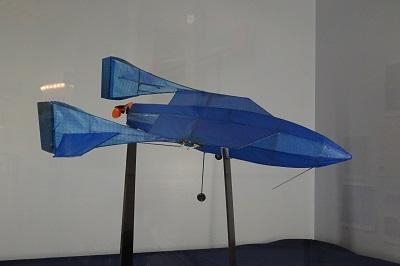Mon, Apr 11, 2016
The National Model Aviation Museum Receives Piece Of Aerospace History
Model aircraft have played a large part in the development of aeronautics for years. The brothers Orville and Wilbur Wright used model airfoils to validate their theories for lift, center of lift shifting, and aircraft control. In this modern day and age of computers it may seem odd that a model aircraft was used in developing techniques to return a spaceship to earth; but that’s just what Burt Rutan did.

Now, National Model Aviation Museum is thrilled to announce its exhibit of the SpaceShipOne RC test model. This piece of aerospace history is significant because it proved the viability of an experimental, nongovernment-funded concept and was flown in front of pilots who would later fly the full-scale aircraft.
In 2004, SpaceShipOne became the first privately built and operated vehicle to achieve manned supersonic spaceflight. The purpose of the program was to accelerate the development and reduce the cost of spaceflight, specifically for commercial passenger use. SpaceShipOne was later retired and is on display at the Smithsonian National Air and Space Museum.
Designed by Burt Rutan, SpaceShipOne was unique in its application of a “feathering” re-entry system. The rear half of the wing and the twin tail booms fold upward along a hinge running the length of the wing, increasing drag while remaining stable.
“It is amazing to see a state-of-the-art, Mach 3-plus aircraft, with a test model made of kite fabric [and] powered by an electric motor,” said Michael Smith, National Model Aviation Museum director. “While computers have become an ever-increasingly important tool in the development of aircraft, engineers still use flying models for aircraft research.”
The model is currently on display at the National Model Aviation Museum at AMA Headquarters in Muncie, IN. To learn more about the museum and its collection of more than 11,000 model aircraft artifacts, use the link below.
(Image provided by the National Model Aviation Museum)
More News
Airport Marking Aids Markings used on runway and taxiway surfaces to identify a specific runway, a runway threshold, a centerline, a hold line, etc. A runway should be marked in ac>[...]
"It is extremely difficult, if not impossible, for manned aircraft to see a drone while conducting crop-enhancing and other aerial applications at low altitudes and high speeds. We>[...]
Aero Linx: The Skyhawk Association The Skyhawk Association is a non-profit organization founded by former Skyhawk Pilots which is open to anyone with an affinity for the A-4 Skyhaw>[...]
“The T-54A benefits from an active Beechcraft King Air assembly line in Wichita, Kansas, where all required METS avionics and interior modifications are installed on the line>[...]
Aero Linx: Aerostar Owners Association The Association offers the Aerostar Owner a unique opportunity to tap an invaluable source of information concerning the care and feeding of >[...]
 ANN's Daily Aero-Term (04.28.24): Airport Marking Aids
ANN's Daily Aero-Term (04.28.24): Airport Marking Aids Aero-News: Quote of the Day (04.28.24)
Aero-News: Quote of the Day (04.28.24) ANN's Daily Aero-Linx (04.28.24)
ANN's Daily Aero-Linx (04.28.24) Aero-News: Quote of the Day (04.29.24)
Aero-News: Quote of the Day (04.29.24) ANN's Daily Aero-Linx (04.29.24)
ANN's Daily Aero-Linx (04.29.24)



